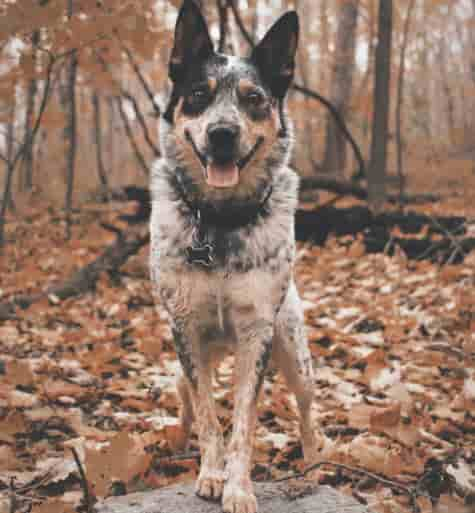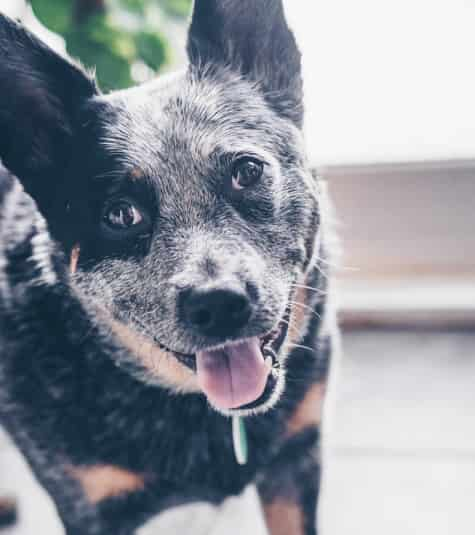Blue Heeler
Otherwise Known As
Australian Cattle Dog
The Blue Heeler also known as Australian Cattle Dog, Australian Heeler and Queensland Heeler is one of the best working dogs around.
While this is quite a handful of nicknames to be sure, no worries, they are all one and the same when it comes to their breed profile.
 Courtesy D Lincoln
Courtesy D LincolnThe development of the Heeler began in the 1800's when herding dogs were needed to control and move several hundreds of wild livestock on cattle drives lasting several days, over the rugged terrain and grazing lands of the Australian outback.
At that time, the traditional herding dogs of the day were not up to working under these harsh conditions. To find a solution, some improvisation was needed.
This led ranchers to begin crossing other breeds including the Scottish Highland Collie, the Dingo, Bull Terrier, Kelpie and Dalmatian to develop the Australian Cattle Dog.
As a result, everything about his physical structure and temperament was geared toward his job.
The Blue Heeler is a compact and symmetrical dog with a muscular body of considerable substance. He can be trained to carry out many tasks.
In addition to cattle, he can move horses, goats, ducks - practically anything that moves!
The Australian Cattle Dog was admitted to the AKC in 1980 and started out with the Working breeds. Subsequently, in 1983 when the AKC Herding group was formed he became a
charter member
Personality and Traits of the Blue Heeler
The Blue Heeler is a highly intelligent trainable dog. He is an independent thinker, but with a strong desire to please, so once you train him, he will take over and do what is expected.
Working is what he likes to do, so if you don't have any barnyard animals for him to herd, train him to do some jobs around the house or he will likely get into unacceptable behavior.
Because the Blue Heeler performed his herding work by nipping at the heels of stock to mobilize them, this traits still remains to a degree and needs to be addressed during the puppy-biting stage through bite inhibition training and socialization.
It is recommended that owners involve their Heeler in flyball, agility or obedience type activities. These are excellent ways to provide him with the mental and physical activities he strongly desires and needs and will result in a happier and calmer pet.
The Blue Heeler is very loyal to his family and has strong guarding instincts, making him an excellent watchdog.
 Courtesy J Diamond
Courtesy J DiamondPhysical Stats
Height: 17-20 inches
Weight: 35-45 lbs.
Color variations: Blue or blue mottled, The permissible markings
are black, blue or tan markings on the head, evenly distributed. Red
Speckle - good even red speckle all over.
The Blue Heeler is double-coated. The under coat is short and dense, and the outer coat is of medium texture
and length.
Shedding is above average especially in the twice yearly seasonal coat blow when it can be awesome.
Regular brushing is needed to prevent build-up around the home under normal circumstances and stepped up during the coat blow.
Routine grooming and includes bathing as needed, along with nail clipping, ear cleaning and tooth brushing.
Also paws should be inspected for any foreign matter or cuts.
Health Profile of the Breed
On average the Blue Heeler is considered a generally healthy breed. It's life expectancy is reported to be in the range of 12 to 15 years, subject to good care and veterinary oversight.
While there are a number of health issues associated with Australian Cattle dogs, not all of them are common or will necessarily occur in a Heeler's life time.
If you are interested in acquiring a Heeler, be sure to do your research on this unique dog and find a conscientious breeder that carries out testing on breeding stock to screen for the most noted health issues
So, here's the run-down on diseases to be aware of and for which testing can be done:
- Congenital hereditary deafness, in one or both ears
- PRA of the (PRCD) form. This is an hereditary disorder that causes deterioration of the rods and cones photoreceptor cells of the retina.
- Hip Dysplasia
- Elbow Dysplasia
Fractures, and cruciate ligament injuries in the form of tears or partial tears are other conditions that have been reported and are not so surprising in such an athletic and high energy breed.
Activity Requirements
Naturally this dog thrives on and needs a considerable amount of exercise and vigorous walks every day. He will do best in a family that can provide a lot of stimulating activity - not just a daily walk.
Insufficient activity will lead to behavior problems which can be avoided by involving the Heeler in dog sports to dissipate some of that extra energy.
This breed does best in a rural setting with considerable yard as well as open areas where he can run freely.
The Blue Heeler With Children?
The Australian Blue Heeler does best with children if he is raised with them from a puppy. Be aware that the herding instinct is strong and needs to be addressed with training and socialization to avoid any nipping activityl
As with any breed of dog, play between children and any breed of dog should always be supervised by an adult.
Book Recommendation

Blue Heeler Bible And Blue Heelers
A complete reference book containing a broad range of information about this incredible herding dog.
